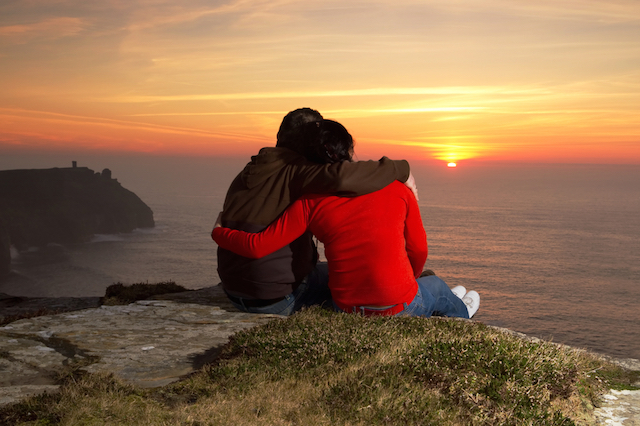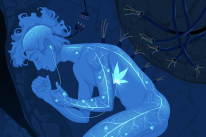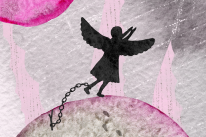
“Anger is a signal, and one worth listening to[…] It exists for a reason and always deserves our respect and attention.” ~Harriet G. Lerner, The Dance of Anger
My journey to authentic safety began, at long last, with my discovery of my own anger.
Anger is my least favorite emotion. I don’t even particularly like its cousins—annoyance, irritation, frustration.
The moment that cemented my profound dislike occurred when I was a teenager.
I had tucked myself away in a corner of the house—in the dark den where my family kept the computer. (Just a word processor—this was in the dark ages before the internet.)
I was doing homework, I think, and an extended family member who was staying with us—someone I had always trusted and looked up to—burst into the room to confront me about something. (I don’t recall what it was, but I doubt it was particularly bad. I was a straight-A student, a people-pleasing, we-must-ALL-play-strictly-by-the-rules kind of child and teen.)
I don’t remember what I said or did; I think I felt distracted. In any case, I somehow neglected to give my family member what he wanted and he grabbed the printed pages I’d set next to the computer.
They were the pages of an important piece of writing I’d recently handed in at school; they’d been returned with a good grade, and, to my pleased delight, some specific words of praise scrawled in my teacher’s handwriting.
My family member grabbed the pages and tore them to express his impotent frustration at not getting the response he’d wanted from me. I so clearly remember the distorted, crazed look of pure rage on his face.
I remember thinking something like,
That’s really not okay. Those pages, with those handwritten words, can’t be replaced. You are out of control. YOU are acting like a tantruming, irrational, destructive child.
Looking at this from an outsider’s perspective, I realize this would probably not strike most people as a bad outburst. It’s pretty mild.
But to put it in context: On the one hand, my parents were pretty nurturing, and angry outbursts were rare. There was some dysfunction, but enough stability and normalcy that I had a strong inner sense of what things should look like between people.
At the same time, there was a lot of mental illness in my immediate and extended family—a lot of weird, distorted thought and behavior, a lot of unpredictability. Part of why I was such a rule-follower, or, rule-worshipper, even, was that it made life feel safe. Contained.
I just hated anything that felt out-of-control.
I yearned for things to feel normal, reasonable, safe. My trusted family member’s irrational rage struck me as emotionally chaotic; the kind of extremely disorderly thing I despised.
I remember moving into a very distant place inside myself, and vowing something along the lines of:
I don’t ever want to behave like that. Ever. I will never be like that.
Many, many years later, as a long-married adult, I experienced a dramatic counterpoint to that.
I was in my own home, and thinking about someone I love very much and how they had recently been betrayed in a way that was cruel, unjust, and profoundly devastating.
Thinking about the person who had done the betraying, I imagined picking up a heavy piece of furniture in the room (far too heavy for me to lift, in actuality), and throwing it at the wall.
The image startled me and I paused. And then I realized: “Oh. I’m angry. I’m feeling anger. This is what that feels like.”
I now realize it was dangerous for me to distance myself so deeply from my own anger. Not because I’ve ever been likely to act out mindlessly on that repressed anger, but because I had placed myself out of hearing range of the vitally important information that anger holds for all of us.
I couldn’t hear myself scream.
In The Dance of Anger, Harriet G. Lerner writes, “Our anger may be a message that we are being hurt, that our rights are being violated… or simply that something is not right.”
Letting the signals of anger go unperceived is potentially quite risky; those messages may turn out to be important.
It’s also risky to ignore things like: a feeling of discomfort, because something about a situation feels weird or “off,” a feeling of jitteriness. A feeling of I’d rather not be here.
All of these sensations are ones that we’re often discouraged from acting on, but perhaps most especially, with our families. With families, distancing ourselves from our bodies and the unpleasant feelings and signals they may hold for us, is so common that it’s a joke.
“Oh, the holidays are coming up? Time to get plastered!”
The lesson our society seems to be teaching here is: it’s best just to ignore how you actually feel.
Of course, our interpersonal lives are filled with friction; it’s impossible to feel totally at ease with everyone, all the time. It can be noble and constructive to avoid fights, to let little things go.
But sometimes, kindly acting on the information that anger has given us is the most important, most constructive thing one can do.
Friendships and family relationships require care and attention to be healthy. Acknowledging where we feel uncomfortable or angry or hurt, and taking gentle action as early and often as we reasonably can, is a way of honouring and protecting a vitally important connection. So that it doesn’t degrade; so that discord and distrust can be repaired; so that both people in a relationship feel safe and can grow, together.
Ignoring things and hoping they’ll magically get better, well, it turns out, that doesn’t work so well.
Anger deferred too long means that something (or someone) is getting extinguished. In the short term, it’s the person ignoring their own inner signals who is silenced. But that can only be endured so long.
Ignored anger goes underground, but it doesn’t go away. Eventually a person’s boundaries must be protected. After enough pressure builds up, anger erupts, and, too often, breaks trust and destroys friendships.
With families, even more is on the line. We are influenced and affected by family members in ways that are well below our conscious awareness. And there is an active risk of harm to that most vulnerable and emotionally vital part of you—that “inner child” deep within.
I can speak from personal experience about something that all too many of us have had to go through.
When healthier members of a family grow—go into therapy, learn to recognize inappropriate or dysfunctional (even abusive) patterns and behaviors—they naturally want to help bring those insights back into their family systems. To initiate healthier patterns, for everyone.
Attempting that can bring about a negative outcome that is simply blindsidingly bad. (It’s hard to anticipate because most relationships don’t operate like family relationships.)
That blindsidingly bad outcome is: that our family system will not only refuse to change along with us, but our family members will deny that there are any problems at all.
Or, they will tell us both that we are wrong about there being a problem, and, that we are the problem.
Which is crazy-making and awful.
In families, there can be tremendous pressure to let our unallowable anger go unaddressed, to deny our own reality until we extinguish us—our truths, our rights, our authentic selves.
That’s a tragic, awful, unjust outcome. That doesn’t have to happen; instead, find someone—or better, many someones—whom you trust, who believe you, and figure things out in a safe, secure, reliable space.
We are far more whole and wiser,* when we listen to the truths that our bodies, minds, and hearts are desperately trying to communicate to us. This is far from a simple process; listening to our feelings does not mean (as I believed for a long time) melding with the strongest feeling, identifying with it, acting without reflection on whatever the feeling wanted me to do.
Figuring out how to listen well to feelings, how to respond to them from a place of separate-but-compassionate insight, what to do with the awareness and energy they offer—this is a long-term process.
Finding a way to stay safe within a family system, on top of all of that—well, to my mind, there is no absolute right course of action for this.
Having the courage and insight to change, and the further courage to protect our evolving well-being inside our families, it can be so complicated, so challenging, (so grueling!) to navigate all of that.
Self-protection might involve avoiding the family (or certain members) while you take time to figure things out; making gentle requests for a family member to do things a little differently; asking one or more members to go to meditation or therapy with you; it might mean a short, long, or forever period of limited or no contact. It might mean a whole host of other things, entirely.
In other words, it can take a whole lot of exploring and planning with people you trust, who stand outside the family, who have expert knowledge and are absolutely committed to your well-being, to find the path that is right for you, that makes your inner self safe and secure.
It took years for me to understand that when I said “no” to owning and knowing my own anger, I was leaving an extremely wise, and powerfully protective piece of myself behind.
Anger can feel combustible; but it’s also energetic and fierce. It can lend us its strength and bravery and confidence.
Of course, everything that bothers or angers us does not, by itself, constitute a reason to take immediate or drastic action. A world of hair-trigger tantrummers would be a nightmarish one.
But if we are made to feel violated or uncomfortable, invaded in a way that feels “not right” in certain intimate relationships, especially relationships within our family of origin, there is no higher or more urgent calling than to heed and protect that inner child.*
You have the right to protect your heart. The little one within needs you. S/he doesn’t need you to commit arson or murder; s/he might even be safest if you lay low for awhile; but no external accusation against you has any merit whatsoever, if you are taking good care of him or her.
It is not mean, it is not rude, it is not selfish, it is not disloyal, it does not make you a bad daughter/son, brother/sister, family member/friend, to protect that inner child.
Protecting our hearts doesn’t make us “bad” people; vigilantly and nonviolently protecting our hearts is exactly what makes it possible for us to be good, kind, generous human beings.
I still crave approval, like the kid and teen I once was. I still want people to think I’m a “good” person (daughter/ niece/ friend). I still hate to let people down.
But that sort of concern doesn’t matter in the least when it comes to my inner child. For her sake, it is irrelevant whether anyone else likes me or my choices, my words, my behavior, my values.
Ultimately, all that matters is that I protect her. Because her safety is what makes all the rest possible—my sanity, my well-being, my commitment to my values.
I can offer the world my best when I am whole; when I feel safe in the ways that matter to my inner, sensitive, wisely aware child. She may not have the cognitive tools to make sense of what’s going on; she needs my help, to understand and to take right action. But she has a deep, instinctual knowledge of what is and isn’t safe for me/ us.
My highest, most sacred duty is to protect my vulnerable inner self; if my inner child is crying for my attention, that is a more urgent concern than anything else. Caring for her doesn’t make me rude or selfish or disloyal or bad; it makes me a kind, whole, responsible adult.
I value kindness above almost anything else; in my most drastically self-protective actions, I have tried to speak carefully, act gently. But I am ruthlessly committed to my well-being, because without it, I’m worse than “mean” or any other name you might call me—I’m nothing. I’m a powerless, silenced sufferer.
My goodness is a fount that flows from my refusal to allow my inner child to be invaded or abused.
My intact wellness—protected by heeding my inner signals and guarding my boundaries—is the source of my integrity and insight and strength.
If something feels not okay, you and I have the right to disengage, to step out and walk away. At. Any. Point. Without permission or explanation. Even, and especially, within your family.
In fact, the title of this post could have been:
You Have the Absolute Right to Take the Nonviolent Actions Necessary For You to Feel SAFE, at All Times, Especially with Your Family
Family patterns change slowly. All too often, violence, abuse, and other unhealthy patterns are passed along for generation after generation. We can interrupt this cycle by taking ruthlessly kind and compassionately wise care of ourselves.
Let us make our world one that is safe for children, one inner child at a time.
—
Footnotes:
*I’m NOT an expert on this, but it’s my understanding that sometimes, in threatening, abusive situations, dissociating from the reality of what we’re feeling is actually a really effective coping strategy. Coping with and coming back from dissociation is, unfortunately, outside the humble scope of this article; but I hope it’s obvious that I symbolically lend my love and support to anyone on that journey.
**I’m sensitive to the fact that responsible adults should actively nurture and protect their own actual child/ren first and foremost (and their inner child second). It seems a tricky thing to balance, and I hope that those seeking a resolution to this question will look, broadly and openheartedly, to the spirit and heart of what I have written here. Also, it is my hope, for all of us who parent or teach or mentor children, that we have been given or found the chance to do vital self-parenting work, first.
Finally: a few minor details included in this piece have been altered to protect the innocent.
About Heidi Juniper
Heidi Juniper is a recovering perfectionist & self-connection coach, who helps people like you use Self-Kindness to connect more deeply to your basic goodness, your emotions, & your innate wisdom. She invites you to visit A Kindful Place--a community to Awaken True Potential thru Meaningful Connection & Self-Growth Tools--or to say hi on Facebook. <<Blessings, Dear Ones.>>













 Though I run this site, it is not mine. It's ours. It's not about me. It's about us. Your stories and your wisdom are just as meaningful as mine.
Though I run this site, it is not mine. It's ours. It's not about me. It's about us. Your stories and your wisdom are just as meaningful as mine. 